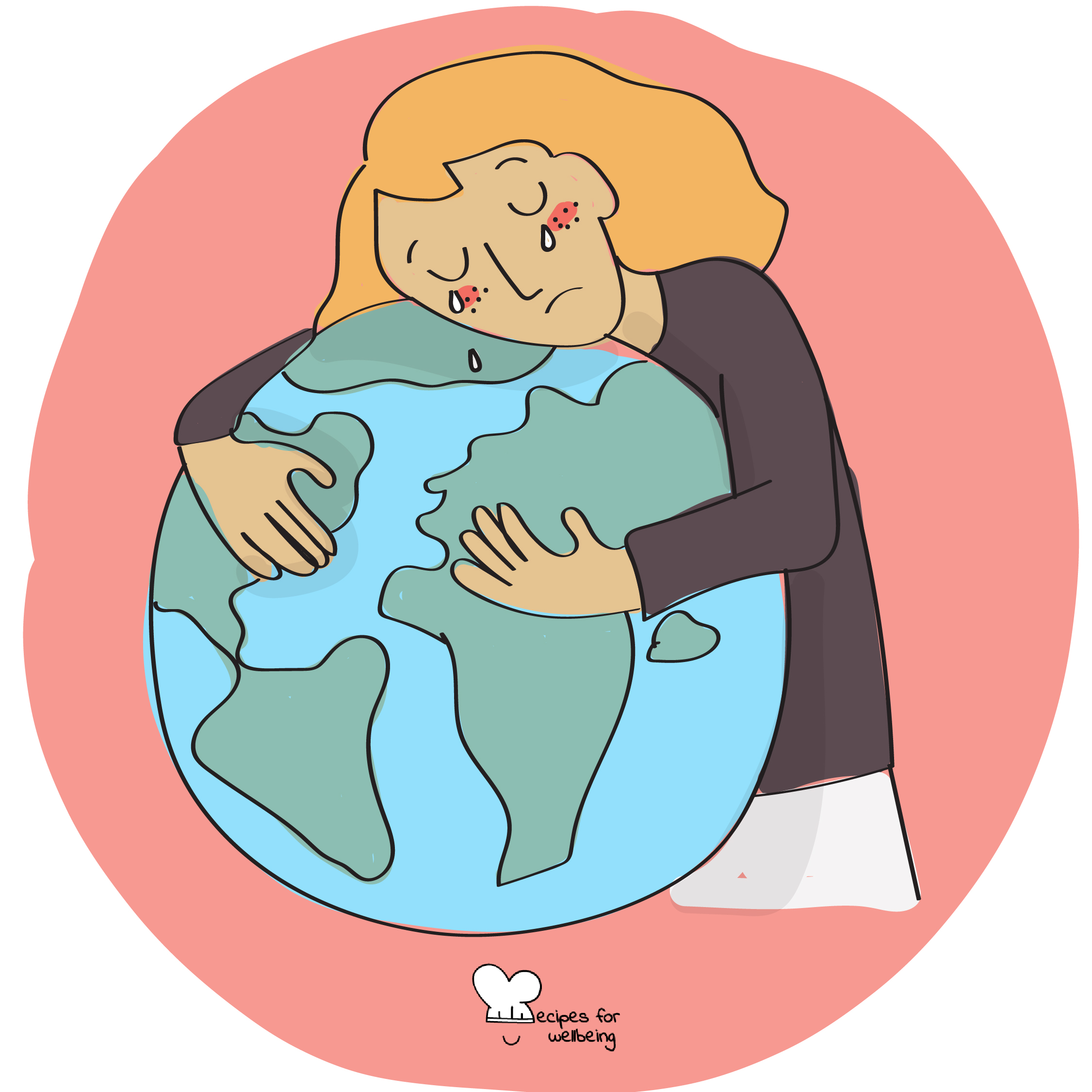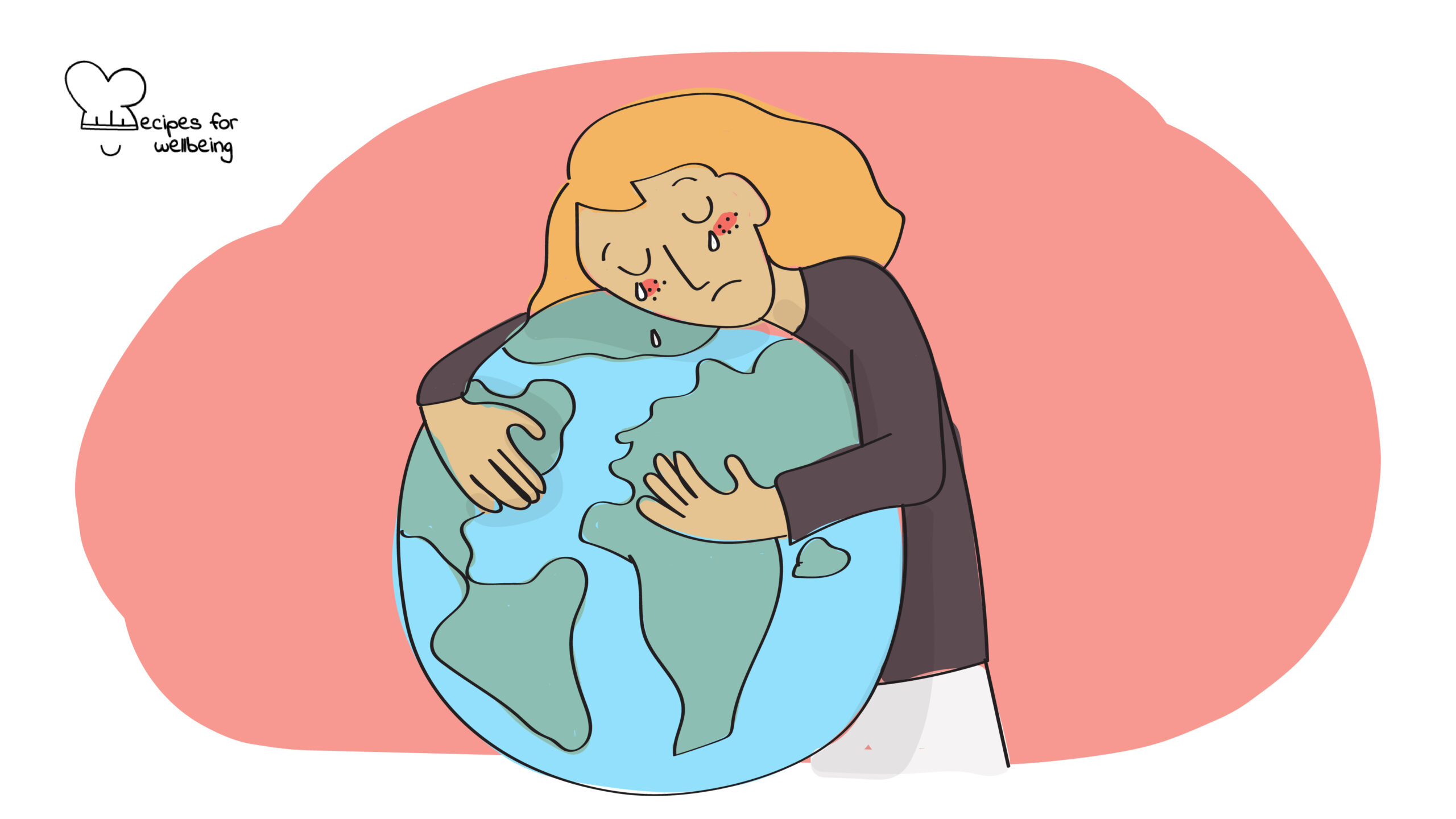
Managing eco-anxiety
I speak for the trees, for the trees have no tongues. ―Dr Seuss
👥 Serves: 1 person
🎚 Difficulty: Medium
⏳ Total time: Ongoing
🥣 Ingredients: Patience and self-compassion
🤓 Wholebeing Domains: Bioempathy, Digital Consciousness, Discomfortability, Positive Emotion
💪 Wholebeing Skills: Acceptance, Awe, Calm, Digital detoxing, Gratitude, Grieving the future, Hope, Nature kinship, Serenity

Managing eco-anxiety
📝 Description
Learn to cope with eco-anxiety.
Ecological (eco-) anxiety is defined as mental distress and anxiety linked to the worsening environmental conditions of the planet, such as pollution, deforestation, floods, extinction, forest fires, lack of access to food, and more. It is considered a relatively new form of anxiety, which emerged in academic discourse as recently as 2007.
This means mental health professionals continue to grapple with it, because it is a realistic response to the impending, looming threat of environmental conditions, yet it has a likelihood of becoming debilitating. Symptoms of eco-anxiety are similar to “regular” anxiety and include, but are not limited to:
- Heightened stress
- Interpersonal difficulties
- Sadness, low mood, or hopelessness
- Depression
- Irritability
- Helplessness
- Grief regarding Earth’s health
- Continuous or interrupting fixation
- Difficulty sleeping
- Verbal or physical aggression
- Difficulties at school or work, potentially related to focus
- Feeling like you are losing control and personal choice
- Feeling displaced like there is no safe place available
- Increased substance uses or abuse
Eco-anxiety can impact anybody, regardless of age, gender, or background. However, researchers have determined that young people, women, indigenous groups, socio-economically disadvantaged communities and people who, for whatever reason, are more connected to the environment, are at a higher risk of experiencing eco-anxiety.
If you suffer from eco-anxiety, your response should be two-fold: 1. validate your eco-anxiety through supporting the environment and 2. boost your mental health to cope with ecological grief.
This recipe has been created by our wellbeing content writer collaborator Marissa Del Mistro inspired by the work of various researchers, including scientist and writer Penny Sarchet and the work of PhD and Doctor of Psychiatry, Dr Timothy Webb.
👣 Steps
Step 1 – Make realistic changes in your life
Sometimes, eco-anxiety is heightened by the stress that singular action is too small or worthless. Yet, psychotherapist Mary-Jayne Rust recommends that changing your lifestyle to be more compatible with your values lowers eco-anxiety.
You may calculate your carbon footprint to learn about your output and how you can make changes. Researchers from Imperial College London’s Grantham Institute offer several ways to do this, such as:
- Follow a sustainable diet that includes less meat and dairy and strive to eat local. You may wish to read the 100-mile diet by J. B. MacKinnon which advocates eating food that can be found, grown, and cultivated within 100 miles of your home. Also consider growing herbs and vegetables in a home garden or a local community garden.
- Avoid food waste by striving to use leftovers and only buying what you need. You can use websites such as Too Good To Go which sells food from local eateries for a significantly discounted price. Compost instead of throwing food in the general waste.
- Limit your driving (or invest in an electric vehicle) and opt for walking, biking, taking trains, busing, or carpooling. If you can’t reach your grocery store by foot or bus, check if they can deliver to your home. If flying, try to limit your flights to 3 a year and opt for economy class as it is more efficient.
- Stop buying disposable items and shop for clothing at thrift stores. Recycle whenever possible.
- Reduce your household energy by turning your electrics off and invest in eco-friendly technology such as a smart water filter, led lights, solar panels, and wireless keyboards.
- Plant trees in your community.
Step 2 – Take action
Researchers explain that using your anger can lead to a more stable emotional response when dealing with eco-anxiety. Anger, when used wisely, can encourage you to become an active, engaged member in advocacy and civil action, and to organise groups.
Spend time protesting, taking collective action and volunteering with like-minded individuals. Volunteering can help you feel effective, and give you a sense of belonging and foster hopefulness. If you are quite active already and are worried that your activism might tip you over to greater anxiety and trauma, consider trying the tips shared in our recipe “Mitigating aftershock for activists”.
Step 3 – Speak to a professional
Eco-anxiety can take a serious toll on your mental health. If your anxiety symptoms are impacting your mood and lifestyle, you should seek a mental health professional.
Although it is not an “officially recognised” diagnosis, the mental health impact of eco-anxiety is very real. Working with a mental health professional can help you manage ecological grief and protect your wellbeing.
The Climate Psychology Alliance North America is a great online starting place for getting free resources about the mental and public health impacts of climate change.
Step 4 – Connect with Nature
Green spaces and spending time in Nature can support you by easing your mind, finding peace, and fostering hope by realising how resilient Nature is.
You should strive to spend around 30 minutes each day getting into Nature, whether that is a stroll through a local green space or having a picnic outside. When you have additional time, connect further through camping, swimming, or going for a hike.
If you can’t easily access green spaces, you may benefit from keeping a rock, twig, shells, fresh or dried flowers, or other natural objects to observe and touch at work or at home when you are feeling overwhelmed. You can also try out our “Virtual Nature walk” from your smartphone or laptop.
Additional ways include ecotherapy or forest bathing.
- Ecotherapy is a therapeutic practice led by professionals/therapists where you combine being outdoors with mental health counselling. It helps to connect people with Nature, often incorporating mindfulness and promoting healing and mental health.
- Forest bathing is an ancient Japanese practice that is not an exercise, but about being one with Nature in a forest, connecting with your sight, hearing, taste, smell and touch. The intention is to slow down, unplug and bring you to the present moment and destress.
Step 5 – Disengage from time to time
We are constantly bombarded by new information from the media, politicians, advertising, billboards, social media, the radio and more. Bad news sells at the expense of our mental health and wellbeing.
While staying informed and educated about environmental conditions is very important, it can become overwhelming and distressing. Make a plan that you can stick to by re-evaluating the sources of information you are receiving and allowing yourself to cut back or unplug from media sources a few times a week. Here are a few recipes for additional guidance: “11 ways to improve your digital boundaries”, “Controlling your social media feeds”, and “Take control of your life with a digital detox”.

